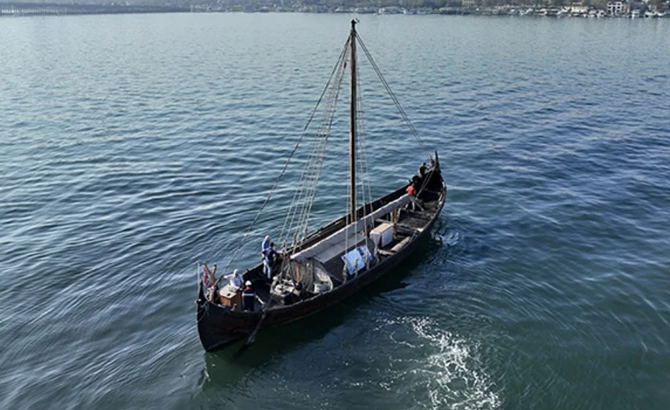“Saga Farmann”, a replica of the 10th century AD Viking sailboat discovered during archaeological excavations, will “winter”, in maritime parlance, at the Şehir Hatları Haliç Shipyard, where it is anchored after being exhibited at the Rahmi M. Koç Museum for 3 months, and then set out to the Mediterranean to complete the historical trade route of the Vikings. will complete.
The sailboat, which arrived in Istanbul in August after a 13-week long voyage with a crew of 12 people, will continue to stay as a guest in Istanbul as it is not suitable to sail in the winter season.
Saga Farmmann, completely handmade from wood and wrought iron, adhering to old techniques, will undergo weekly inspections by a special team at the Haliç Shipyard until April.
In April, the ship’s crew and technical staff will come to the shipyard and complete the final maintenance work. The ship will sail to the Mediterranean and go to Norway, following the trade route followed by the Vikings 13 centuries ago.
The ship is planned to travel to the coastal cities of Greece, the Adriatic Sea, Italy, Tunisia, France and Spain via the Sea of Marmara and the Dardanelles, then pass through the Strait of Gibraltar and go to its first stop, Tonsberg.
The sailboat, which arrived in Istanbul at the beginning of August with a voyage of approximately 90 days, will break new ground by staying as a guest in the Turkish seas for a total of 8 months.
“The interest in Vikings in Turkey is truly surprising”
Lars Bill, project manager and one of the captains of the Saga Farmann sailboat, told AA correspondent that the ship came by following the route of the commercial journey of the Vikings to Istanbul centuries ago.
Stating that they were very well received in Istanbul, where they arrived after a 3-month voyage, and that Viking fans came to visit wherever they anchored, Bill stated that they were pleased with the interest in the Rahmi M. Koç Museum, where the ship was exhibited for 3 months.
Captain Bill described his impressions at the Rahmi M. Koç Museum as follows:
“We have always been welcomed very well in Istanbul. Vikings came to Miklagard (the name meaning the big city the Vikings used for Istanbul) very often to trade. We have a common history. The interest in Vikings in Turkey is truly surprising in this respect. Young people come on board and “They felt the environment, took selfies. They smelled the wood here, just like they would have felt on a Viking ship 1000 years ago. It was a very special experience for them.”
Stating that the ship anchored at the Haliç Shipyard after the exhibition at the museum, Bill said, “We have the opportunity to protect the ship here throughout the winter before sailing to the Mediterranean. We will come back as a team towards April and do the painting and final repairs. Since it is a ship made of wood, it must remain in the water. From the water.” “We don’t want it to be taken out and left waiting in the sun,” he said.

Returning via the route used by the Vikings
Captain Bill emphasized that the historical route of the Vikings is a source of inspiration and guidance for them, and said, “We have many ideas for the return route. We will leave the Sea of Marmara and go to Italy, visit the coasts. Maybe we will also go to Africa, to Tunisia. Vikings “We will try to go through the Mediterranean on a route similar to the routes used by the Vikings. Wherever we go, we will meet with academics, archaeologists and experts and introduce the ship to people,” he said.
Explaining that Saga Farmmann came and went intermittently during his stay in Istanbul, Bill described his impressions there as follows:
“The Turks helped us a lot, they were very friendly. We met not only the officials, but also many people in restaurants and hotels. We told them that we came on a Viking ship and chatted. It was a very nice experience for us, too.”
The opinions expressed herein are the author’s and not necessarily those of News2Sea.
#Viking #sailboat #Saga #Farmann #winter #Istanbul